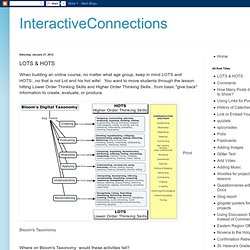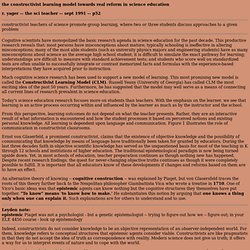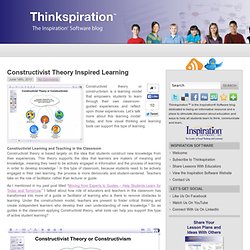

LOTS & HOTS. When building an online course, no matter what age group, keep in mind LOTS and HOTS...no that is not Lot and his hot wife!

You want to move students through the lesson hitting Lower Order Thinking Skills and Higher Order Thinking Skills...from basic "give back" information to create, evaluate, or produce. Print Bloom's Taxonomy Where on Bloom's Taxonomy would these activities fall? 1. Reflective Meditation:Creating a "safe" and private blog through your settings can provide an environment where students can really discuss what they think and feel. 2. 4. 5.
LOTS & HOTS. DA.12.3.13.DreamBox.pdf. Vanweringh: This is a great representation... LOTS TO HOTS. Backwards and in High Heels: Teaching (Well) Online. Why online teaching requires rigorous training I am presently working in South America—a continent of gente amable, stunning vistas, and an exploding online learning environment. In my work with the Government of Ecuador’s National Education University (helping to conceptualize and design its online and blended programs), I have had numerous conversations with various representatives from universities, governments, and online learning programs—in Europe and North and South America—about online learning. One impression continues to nag at me from these conversations — there seems to be a lack of concern for preparing instructors to teach online. We know that good teaching matters in the classroom. But if a great teacher is to the classroom what Fred Astaire was to dancing, then an online teacher must be even better because teaching online is far more challenging than teaching face-to-face.
Online learning goes global This is no longer just a wealthy or middle-income country concern. Notes. Kirkpatrick’s Levels and Bloom’s Taxonomy. Submitted by Leslie Allan on March 1st, 2013 Are you confused on how to incorporate Donald Kirkpatrick’s Level 2 and Level 3 in the design of your training program?

Level 2 is about how much and how well your training participants learned. Level 3 asks how much of that learning is translated into behavior on the job. But hang on a minute. Isn’t learning – effective learning – supposed to be about behavior? I have been advising trainers to incorporate how they plan to do the program evaluation into their initial program design – starting with the end in mind, as we say.
LOTS TO HOTS. Emerging Perspectives on Learning, Teaching and Technology. Learning Models. Castle.eiu.edu/~scienced/5660/gotta/G-4_R-3.html. R. yager -- the sci teacher -- sept 1991 -- p52 Cognitive scientists have monopolized the basic research agenda in science education for the past decade.

This productive research reveals that: most persons have misconceptions about mature; typically schooling is ineffective in altering misconceptions; many of the most able students (such as university physics majors and engineering students) have as many misconceptions about science as the average high school student; it is difficult to simulate the exact pathway for learning; understandings are difficult to measure with standard achievement tests; and students who score well on standardized tests are often unable to successfully integrate or contrast memorized facts and formulas with the experience-based interpretations they have acquired prior to instruction.
Much cognitive science research has been used to support a new model of learning. This most promising new model is called the Constructivist Learning Model (CLM). Leyden note: Thinkspiration™ The Inspiration® Software Blog. Constructivist theory or constructivism is a learning model that empowers students to learn through their own classroom-guided experiences and reflect upon those experiences.

Let’s talk more about this learning model today, and how visual thinking and learning tools can support this type of learning. Constructivist Learning and Teaching in the Classroom Constructivist theory is based largely on the idea that students construct new knowledge from their experiences. This theory supports the idea that learners are makers of meaning and knowledge, meaning they need to be actively engaged in information and the process of learning in order to develop knowledge. In this type of classroom, because students need to be actively engaged in their own learning, the process is more democratic and student-centered.
Teachers take on the role of facilitator, rather than lecturer or guide. How are you incorporating constructivism into the classroom? Mona Westhaver.